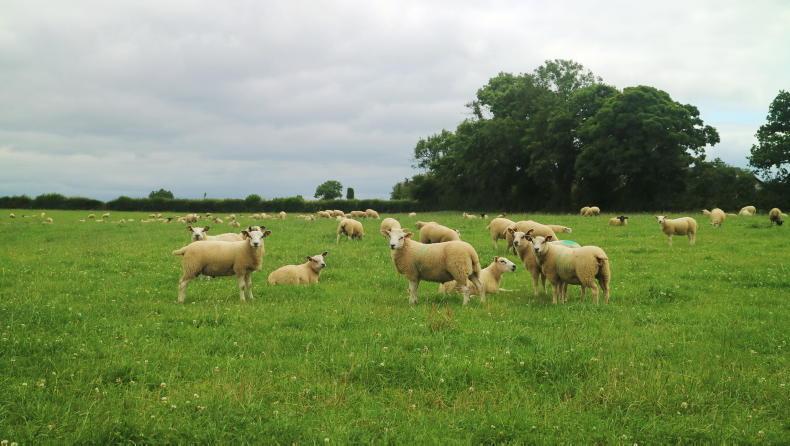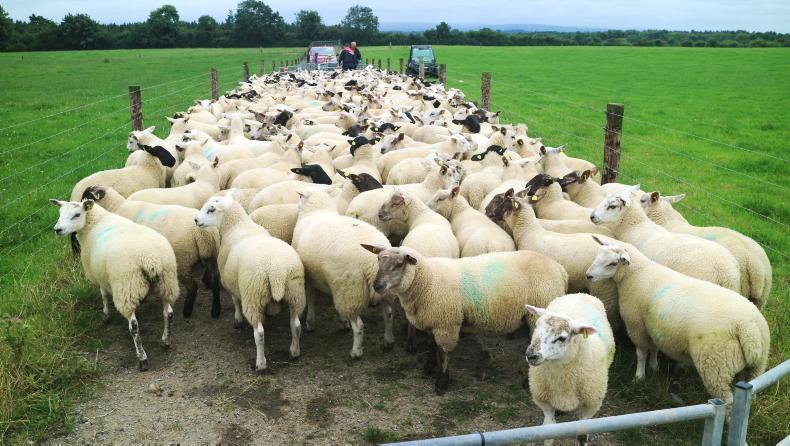It has been a busy few weeks for Tullamore Farm manager Shaun Diver with important farm tasks taking place alongside preparations for the upcoming open day.
The first two batches of lambs were weaned on 4 July with another batch weaned on 8 July.
Lambs were weighed at weaning with weights recorded via the Sheep Ireland performance recording app.
Shaun was happy with the performance, despite the challenging weather with lambs recording an average weaning weight of 37.66kg at an average of 104 days of age (14.8 weeks).
Approximately 88% of lambs were aged between 90 and 115 days, owing to a relatively condensed lambing period with 5% of lambs aged from 115 to 121 days and 7% from 80 to 90 days, the latter mainly being lambs born to yearling hoggets.
Lambs recorded an average daily gain (ADG) since birth of 300g. Again, Shaun is happy with such performance with grass supplies and quality coming under significant pressure in late lactation. The ADG of lambs at 40-day weighing was in the region of 310g with performance holding relatively well since then.
There is a wide spread in the performance of lambs with the top-performing lots gaining from 350g to over 400g daily, while the poorest-performing lots gaining from 200g to 250g per day. A small batch of lambs suckling yearling hoggets had access to creep feed with a similarly wide differential between these lambs.
Drafting progress
A second batch of 32 lambs were identified for drafting at weaning and were slaughtered last Thursday.
The average slaughter performance of lambs is captured in Table 1. A dozen lambs which were either deemed to have an insufficient fat cover at the last drafting date, or which recorded an above average kill-out, exceeded the maximum carcase weight of 21.5kg and killed from 22kg to 24kg carcase weight.
In total, there was 16kg of free meat across the batch with this figure likely to drop, with drafting now moving to fortnightly and possibly weekly weighing if deemed necessary.
A handful of these were U grading lambs which achieved a killout of 49% to 50%.
Lambs are marketed through the Offaly Quality Lamb Producer Group with overweight U grading lambs missing out on their 10c/kg conformation bonus.

Performance from birth to weaning has been relatively good with lambs recording an average daily gain of 300g and weighing 37.66kg on average.
The average killout percentage of 46.5% is pretty good given the year but it hides the variation between different type lambs.
Stronger ram lambs bred from Mule ewes and exhibiting more maternal genetics killed in cases back to 43% to 45%, with continental lambs bred to Texel-cross and Suffolk-cross ewes typically killing above 46%. All lambs recorded an optimum fat cover score of three.
Lambs have been batched into one large group since weaning for ease of management ahead of next week’s open day.
After the event a finishing group of ram lambs will likely be segregated and offered concentrate supplementation. In recent years, concentrate supplementation has been introduced to ram lambs anywhere from immediately post-weaning to the end of August with grass supplies and lamb performance typically dictating the date of introduction.
While lamb performance is largely on target, grass supplies remain tight and, as such, the focus will be to keep lambs moving to be in a better position to build grass supplies as the farm progresses through August.

Lambs were weighed, dag and lameness scored this week by Bríd McClearn, TechCare project and Martin Warde, Teagasc Technician as part of the Teagasc TechCare project.
While grass demand from ewes has reduced, demand is increasing on the suckler side.
Ewe condition is pretty good but it is likely that younger ewes will require a longer period of preferential treatment prior to joining with rams this year.
Ewes will remain as one grazing group until dried off and will then be split into two grazing groups – a group of ewes used to clean out paddocks and fed to maintenance and a group of ewes which will be used to clean off higher-quality swards and regain condition.
Review
The planned feeding programme will be discussed in greater detail on the sheep stand at the open day. This will include a review of lamb finishing costs and finishing plans for lambs.
The sheep stand will discuss the physical and financial performance from the sheep system, including a detailed analysis of slaughter performance.
The farm collects extensive production data through the Sheep Ireland performance recording app for commercial flocks and Sheep Ireland personnel will be in attendance to explain the benefits of the app, show farmers how they can set up their own flock and discuss wider aspects of the Sheep Ireland breeding programme and industry developments.
The farm has also joined the EU TechCare project led by Teagasc in Ireland with information available on the day.
All sheep will be on show, including a first view of the farm’s new flock of Easycare sheep. The farm purchased 44 Easycare females aged from ewe lambs to third-crop ewes in 2023 and have plans to double this number in 2024.
Mule ewes have been the mainstay of the flock since the farm project began and will be replaced with Texel x Mule and Suffolk x Mule and Easycare sheep in the coming years.
The merits of each breed type will be discussed and breeding plans for 2024/2025.
All aspects of the sheep flock’s physical and financial performance will be discussed at the open day. Lambs have gained 300g from birth to weaning and plans for finishing lambs will be detailed. The farm’s breeding programme for 2024/2025, including an overview of the Easycare breed addition, will be discussed in greater detail.
It has been a busy few weeks for Tullamore Farm manager Shaun Diver with important farm tasks taking place alongside preparations for the upcoming open day.
The first two batches of lambs were weaned on 4 July with another batch weaned on 8 July.
Lambs were weighed at weaning with weights recorded via the Sheep Ireland performance recording app.
Shaun was happy with the performance, despite the challenging weather with lambs recording an average weaning weight of 37.66kg at an average of 104 days of age (14.8 weeks).
Approximately 88% of lambs were aged between 90 and 115 days, owing to a relatively condensed lambing period with 5% of lambs aged from 115 to 121 days and 7% from 80 to 90 days, the latter mainly being lambs born to yearling hoggets.
Lambs recorded an average daily gain (ADG) since birth of 300g. Again, Shaun is happy with such performance with grass supplies and quality coming under significant pressure in late lactation. The ADG of lambs at 40-day weighing was in the region of 310g with performance holding relatively well since then.
There is a wide spread in the performance of lambs with the top-performing lots gaining from 350g to over 400g daily, while the poorest-performing lots gaining from 200g to 250g per day. A small batch of lambs suckling yearling hoggets had access to creep feed with a similarly wide differential between these lambs.
Drafting progress
A second batch of 32 lambs were identified for drafting at weaning and were slaughtered last Thursday.
The average slaughter performance of lambs is captured in Table 1. A dozen lambs which were either deemed to have an insufficient fat cover at the last drafting date, or which recorded an above average kill-out, exceeded the maximum carcase weight of 21.5kg and killed from 22kg to 24kg carcase weight.
In total, there was 16kg of free meat across the batch with this figure likely to drop, with drafting now moving to fortnightly and possibly weekly weighing if deemed necessary.
A handful of these were U grading lambs which achieved a killout of 49% to 50%.
Lambs are marketed through the Offaly Quality Lamb Producer Group with overweight U grading lambs missing out on their 10c/kg conformation bonus.

Performance from birth to weaning has been relatively good with lambs recording an average daily gain of 300g and weighing 37.66kg on average.
The average killout percentage of 46.5% is pretty good given the year but it hides the variation between different type lambs.
Stronger ram lambs bred from Mule ewes and exhibiting more maternal genetics killed in cases back to 43% to 45%, with continental lambs bred to Texel-cross and Suffolk-cross ewes typically killing above 46%. All lambs recorded an optimum fat cover score of three.
Lambs have been batched into one large group since weaning for ease of management ahead of next week’s open day.
After the event a finishing group of ram lambs will likely be segregated and offered concentrate supplementation. In recent years, concentrate supplementation has been introduced to ram lambs anywhere from immediately post-weaning to the end of August with grass supplies and lamb performance typically dictating the date of introduction.
While lamb performance is largely on target, grass supplies remain tight and, as such, the focus will be to keep lambs moving to be in a better position to build grass supplies as the farm progresses through August.

Lambs were weighed, dag and lameness scored this week by Bríd McClearn, TechCare project and Martin Warde, Teagasc Technician as part of the Teagasc TechCare project.
While grass demand from ewes has reduced, demand is increasing on the suckler side.
Ewe condition is pretty good but it is likely that younger ewes will require a longer period of preferential treatment prior to joining with rams this year.
Ewes will remain as one grazing group until dried off and will then be split into two grazing groups – a group of ewes used to clean out paddocks and fed to maintenance and a group of ewes which will be used to clean off higher-quality swards and regain condition.
Review
The planned feeding programme will be discussed in greater detail on the sheep stand at the open day. This will include a review of lamb finishing costs and finishing plans for lambs.
The sheep stand will discuss the physical and financial performance from the sheep system, including a detailed analysis of slaughter performance.
The farm collects extensive production data through the Sheep Ireland performance recording app for commercial flocks and Sheep Ireland personnel will be in attendance to explain the benefits of the app, show farmers how they can set up their own flock and discuss wider aspects of the Sheep Ireland breeding programme and industry developments.
The farm has also joined the EU TechCare project led by Teagasc in Ireland with information available on the day.
All sheep will be on show, including a first view of the farm’s new flock of Easycare sheep. The farm purchased 44 Easycare females aged from ewe lambs to third-crop ewes in 2023 and have plans to double this number in 2024.
Mule ewes have been the mainstay of the flock since the farm project began and will be replaced with Texel x Mule and Suffolk x Mule and Easycare sheep in the coming years.
The merits of each breed type will be discussed and breeding plans for 2024/2025.
All aspects of the sheep flock’s physical and financial performance will be discussed at the open day. Lambs have gained 300g from birth to weaning and plans for finishing lambs will be detailed. The farm’s breeding programme for 2024/2025, including an overview of the Easycare breed addition, will be discussed in greater detail. 







 This is a subscriber-only article
This is a subscriber-only article













SHARING OPTIONS: